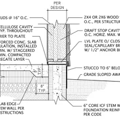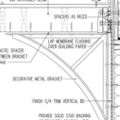CLT vs SIP exterior wall construction
Caroline Di Diego| Posted inGreen Building Techniqueson
Pacific northwest, 4C climate zone. (asking for a friend)
GBA Detail Library
A collection of one thousand construction details organized by climate and house part
Search and download construction details










Replies
About the only reason for either one is for speed of construction. Neither option is cost effective compared to standard stick built.
There is a benefit for CLT for sound especially when it comes to multifamily units.
There is a good thread about a CLT build on the site:
//m.etiketa4.com/article/wolfe-island-passive-building-with-cross-laminated-timber
Yikes.
Is there a third option?
One has integral continuous foam insulation. The other looks nice, and requires continuous exterior insulation.
What are your [friend's] project goals?
CLT can sequester carbon and can cost-effectively replace concrete and steel on mid-rise projects. It can be used for single-family homes but it's not common, or cost-effective except perhaps for some very unusual projects.
SIPs have relatively high embodied carbon, are vulnerable to various construction errors and a house built with SIPs probably won't last more than a few decades without major repairs. But they install quickly.
为了处理一个particular misapprehension you may or may not be harboring:
The R-value of CLT is about 1.25 per inch. Washington State requires a wall R-value of R-21. So if you're relying PURELY on CLT for insulation, as some of the proponents declare is feasible, you're looking at 16 inches (40cm) thickness of solid glued-together wood. I can barely find any cost estimates for CLT, but what I can find indicates that $1000 per cubic meter is a reasonable ballpark estimate. That means you'd be paying about $250 per square meter, or $23 per square foot.
This is much, much higher than you would pay for a cavity wall of any type, or for SIPS, or for ICFs, or for a sane CLT assembly featuring 4"-6" thick panels and some other form of insulation.